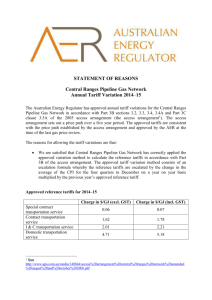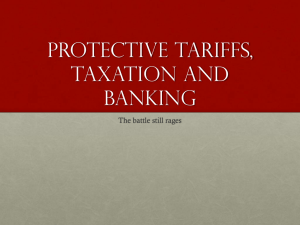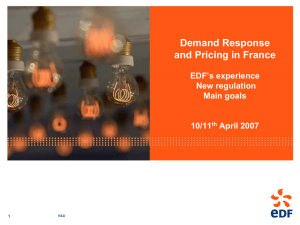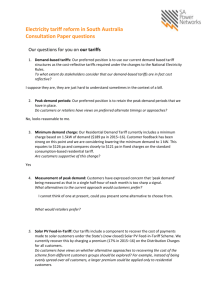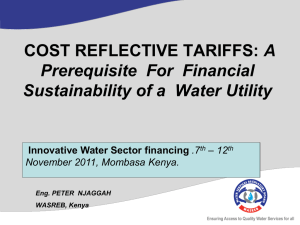Chapter 7 Rate-Setting Principles And Procedures
advertisement
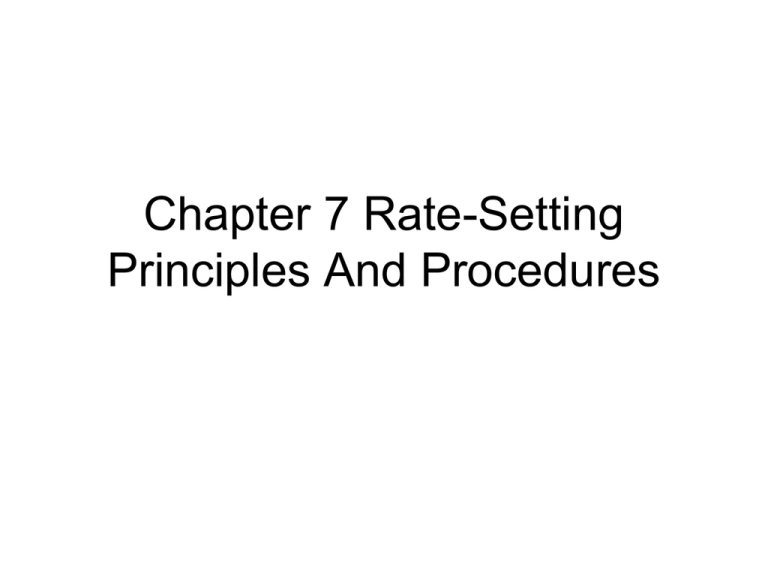
Chapter 7 Rate-Setting Principles And Procedures 7.1 Introduction • Final (five) step---determining prices • Basic level: dividing the allocated costs by appropriate consumption measures. • In practice, more complex: different rate-setting and tariff design; different social and economic goals 7.2 Billing Determinants ---the units on which prices are levied. • Based on: (1) overall energy consumption & peak demand (2) types of cost allocators used to divvy up costs bw the diff rate classes • Components: (1) accurate forecast: naïve forecast; sophisticated forecast; simultaneous equations (2) weather normalization Estimation Methods Regulators: (1) Select the types of billing determinants to be uses (2) Choose to base on historical test year data or rate year Why rate and tariff structures take numerous forms—the design characteristics of natural gas and electric distribution. (1) Serve peak loads (both NG &electric) (2) So regulated rates and tariffs always incorporate multiple consumption measures and take one different structures. (3) Electric: both consumption and peak demand will change constantly NG: more complex, depends on whether the focus is on local distribution to retail consumers or pipeline transport for wholesale consumers (4) Different types of peak demand are calculated by utilities to estimate rates and tariffs. coincident peak; non-coincident peak (5) Utilities also estimate load factors for rate and tariff setting. system load factor; sector load factor; customer load factor • Demand info is more difficult to gather than usage info. peak demand studies • NG faces measurements issues different from those of electric utilities. (cold weather, storage retail tariffs) Forecasting • Focus on conceptual aspects of forecasting billing determinants. 1. Forecasting Energy Consumption (easier) (1) econometric way: time series data (2) bottom-up engineering approach: special equipments 2. Forecasting peak demand (harder) Reasons for the difficulty: (1) forecasters tend to be less adept at predicting extreme events (peak demand) (2) the physical characteristics of a distribution or transmission system (solved by simultaneous equations) (3) investment impacts of additional demand and additional customers classified into: horizontal growth & vertical growth conflicting goals: obligation to serve & fair, just and reasonable Weather Normalization Method • Degree day: heating degree day (HDD)=diff bw average temperature for the day & a reference average temperature (68 F) cooling degree day (CDD)= (same manner) • Humidity; cumulative temperatures over the past few days; hours of daylight • Linear regression techniques energy consumption= Fn (energy price, no. of customers, weather conditions) • Defining “normal weather: the average over the previous 30 years (not the best predictor) 7.4 Alternative Design Structures • (1) (2) (3) (4) (5) (6) (7) (8) Under traditional ratemaking principles (excluding incentive rate designs such as performance-based regulation), there are 8 broad types of tariff design: One-part tariffs Two-part tariffs Multiblock tariffs Incentive rate structures Entry-exit tariffs Interruptible rates Time-of-use rates Seasonal rates • (1) One-part tariff: simply a single volumetric charge based on consumption (but any single price is charged with welfare loss) • (2) Two-part tariff: combines a fixed charge with a volumetric charge. (See Figure next page): the variable cost component would be set such that .P*=MC, consumption Q* the firm collect the shaded area to cover the fixed costs So the regulator could set a fixed charge equal to this amount divided by the expected number of customers in the rate year. Figure: two-part tariff pricing • (3) Block tariffs: --distribute the price among blocks of consumption. P can be set efficiently w/o resorting to a fixed charge. Figures: next two pages Three-part declining block price structure Increasing block price structure Reasons for designing increasing block rates: subsidies for low-income consumer; increasing MC structures; social policy designed to reduce energy consumption) Figure: Bock Rate Design Figure: Block rate design under increasing marginal cost • (4) Incentive rate: --paired with special economic development rates that provides lower-cost energy in exchange for a firm creating new jobs. Problem: easy to go from incentive to cross-subsidy. • (5) Entry-exit: Ex: European natural gas pipeline similar to multipart tariff with fixed charges (entry and exit fees) and variable charges ( commodity usage fees) • (6) interruptible rates: ---the utility offers lower price in exchange for an ability to curtail or interrupt service to customers. (usually during periods of high demand) interruptible rates: depends on how the firm’s fixed costs are allocated among customers Customers frequently argues that they are allocated additional fixed costs that would otherwise be allocated to interruptible customers. --price discrimination • Above argument is weak for reasons as: (1) probability of service interruption, not a guarantee of interruption. (2) a guarantee of interruption lacks foundation of economic efficiency and equity (3) many interruptible customers, will have alternatives to taking regulated service. • (7)Seasonal rates (8) time-of-use rates --incorporate the time dependence of consumption. Drawbacks of these two: (1) Customers do not like overall rates to increase in peak seasons, wrongly perceiving that the regulated firm is taking advantage of them. (2) Time-of-use rates can only be implemented if customers have more sophisticated meters that measures consumption in each hour. (3) Both conflict with regulatory goals of rate stability. Embedded and Marginal Cost Method 1. Embedded Cost Approaches • adding up the prudent and known-and-measureable costs incurred by a firm to establish the firm’s revenue requirement. • Rely on accounting costs on company’s books for the test year. 2. Marginal Cost Approaches • Based on the principles of competitive markets—the amount consumers are willing to pay for the last (marginal) unit of a good or service is the cost of producing that unit. • Allocative efficiency • take observed demand as a given, set rates equal to MC at that level of output. • Revenue checks show whether over- or underrecovery. apply revenue reconciliation (Ramsey Pricing, Inverse Elasticity) • Equal Proportion of MC (EPMC): increasing MC in proportion to the revenue diff. (additional cost are allocated w/o regard to price sensitivity.) • Problem: charging all customers the marginal P firms collect revenue requirements only by chance needs reconciliation. otherwise, if P diverges from MC, no way to know whether allocatively efficient. 3. Which Approach is Better? Difference lies in—how to define “cost” Embedded cost: accounting costs on the company’s books for the test year as the basis for setting rates and tariffs. Marginal cost: incremental costs of the firm providing an additional unit of production. Supporters of— Embedded: outweigh imperfect approximations to MC pricing MC pricing: efficient resource allocation cannot be had w/o it. 1. Pipeline Tariff Methods: --key point: whether access to pipeline capacity is based on a contract carriage or an entry-exit regime. Contract carriage: (US, Canada, most Latin America) a pipeline assigns a contract amount of capacity to the shipper on any given day; Take-or-pay; capacity right. Two methods to allocate fixed and variable pipeline costs: zone-gate & Mcf-mile • Zone gate: cost are first allocated by geographic zone, then based on zone-specific billing determinants. Problem: arbitrary • Mcf-mile: to calculate “distance-weighted” allocation factors. Good side: No specific zones 2. Peaker Methods: --whereas energy revenues are simply revenues from the sale of electricity on a volumetric, capacity revenues are meant to compensate generators for the fixed costs of providing capacity to the system. ensure enough investment in new generating plants and to maintain long-term system reliability. Same concept of regulators: capacity payments are designed to compensate investors for the fixed investment and operation costs associated with a peaking unit. In determining the capacity payments, regulators: (1) choose an “efficient” peaking plant (2)calculate the total fixed investment cost for the plant. (3) levelize the total fixed investment cost over the plant’s expected lifetime. (4) add a fixed O&M cost to the annual fixed cost 3. Electric Transmission Tariffs: --electric transmission: large fixed costs and small variable ones. None methods we are aware of has provided appropriate economic signals to encourage long-term investment. Ex: Argentina: transmission usage charge (locational pricing) Great Britain: a connection charge and a usage charge (MC pricing)

